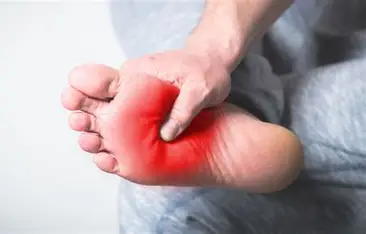What is Foot Pain?
Foot pain is an unpleasant sensory and emotional experience following perceived damage to any tissue distal
to the tibia or fibula; including bones, joints, ligaments, muscles, tendons, apophyses, retinacula, fascia, bursae, nerves, skin,
nails, and vascular structures. Foot pain is experienced by 17 to 42% of the adult population. It is disabling in nearly half of
these cases and can impair mood, behavior, risk of falls, self-care ability, and quality of life.
Foot pain is complex, and
difficulties in accurately diagnosing the source of pain and cause of tissue damage can impair clinical management of the pain.
However, most people with foot pain do not seek professional treatment, even when the pain is disabling. There is clearly a need to
improve the provision of foot care to people suffering such pain. Foot pain can affect any part of your foot, from your toes to your
Achilles tendon at the back of your heel. Although mild foot pain often responds well to home treatments, it can take time to resolve.
Causes of Neck Pain
Injury, overuse, or conditions causing inflammation involving any of the bones, ligaments, or tendons in the foot
can cause foot pain. Arthritis is a common cause of foot pain. Injury to the nerves of the feet may result in intense burning pain,
numbness, or tingling (peripheral neuropathy).
Some common causes of foot pain include:
- Achilles tendinitis
- Achilles tendon rupture
- Avulsion fracture
- Bone spurs
- Broken foot
- Broken toe
- Bunions
- Bursitis (joint inflammation)
- Corns and calluses
- Diabetic neuropathy (nerve damage caused by diabetes)
- Flatfeet
- Gout (arthritis related to excess uric acid)
- Haglund's deformity
- Hammertoe and mallet toe
- High heels or poorly fitting shoes
- Ingrown toenails
- Metatarsalgia
- Morton's neuroma
- Osteoarthritis (disease-causing the breakdown of joints)
- Osteomyelitis (a bone infection)
- Paget's disease of bone
- Peripheral neuropathy
- Plantar fasciitis
- Plantar warts
- Psoriatic arthritis
- Raynaud's disease
- Reactive arthritis
- Retro calcaneal bursitis
- Rheumatoid arthritis (inflammatory joint disease)
- Septic arthritis
- Stress fractures
- Tarsal tunnel syndrome
- Tendinitis
- Tumors
Risk Factors That Are Associated With Foot Pain
A risk factor is something that raises the chances of getting a health problem. Foot pain is more common in
children and older adults. Women may also be at higher risk of wearing high-heeled shoes. Some common risk factors associated with
high chances of having foot pain are:
Certain jobs:some jobs may raise the risk of
injury, such as construction. Other problems may be from repetitive use on the job, such as in the foodservice industry
Sports:People who do high-impact exercise are at risk for plantar fasciitis, heel spurs,
sesamoiditis, Achilles tendinopathy, and stress fractures..
Smoking:Smoking slows healing.
This may lead to foot problems that become painful because they do not heal properly.
Certain health problems, such as:
DiabetesPeople with diabetes are at risk for severe foot infections due to poor circulation.
Obesity:People who carry excess weight put more stress on their feet. This also raises the risk
of foot or ankle injuries.
Other health problems:eople with osteoarthritis, rheumatoid
arthritis, gout, and some inherited abnormalities are also at risk for foot pain.
Preventive Measures For Avoiding Foot Pain
The foot plays a very important role when standing and walking. It must compensate for every structural abnormality in
the skeleton above. The failure of the foot to adequately adapt to structural imperfections in the body can result in a breakdown of the foot
structure. It is this collapse of the foot - which leads to flat feet, heel spurs, bunions, plantar fasciitis, and many other chronic foot
discomforts. Common preventive measures to avoid foot pain include:
- Choose comfortable, roomy, and well-cushioned shoes.
- Avoid shoes with high heels and narrow toe areas.
- Maintain a healthy weight.
- Stretch before engaging in vigorous exercise.
- Sit down during breaks
- Practice good foot hygiene.
- Always wear footwear when you’re outdoors to protect your feet.
The foot plays a very important role when standing and walking. It must compensate for every structural abnormality in the skeleton above.
The failure of the foot to adequately adapt to structural imperfections in the body can result in a breakdown of the foot structure. It is
this collapse of the foot - which leads to flat feet, heel spurs, bunions, plantar fasciitis, and many other chronic foot discomforts. Common
preventive measures to avoid foot pain include:
- Choose comfortable, roomy, and well-cushioned shoes.
- Avoid shoes with high heels and narrow toe areas.
- Maintain a healthy weight.
- Stretch before engaging in vigorous exercise.
- Sit down during breaks
- Practice good foot hygiene.
- Always wear footwear when you’re outdoors to protect your feet.
- Stay hydrated
Physiotherapy Treatment for Foot Pain
Foot Pain Physiotherapy aims to relieve pain and treat the condition through methods as manual therapy,
manipulation, and exercises. It is important to seek medical advice from a physiotherapist to get an accurate diagnosis of your
condition. Only after getting an accurate diagnosis, you will be able to apply the appropriate treatment methods to resolve the
pain. Your physiotherapist will run a thorough assessment to accurately determine the cause of your pain. Based on the causes of
your pain, a physiotherapist will help to provide immediate pain relief through various treatment modalities which include:
- Strengthening and Stretching exercises
- Mobilization and manipulation
- Ultrasound heat therapy
- Deep massage
- Foot Orthoses
- Range of movement exercises
- Education on footwear and activity


